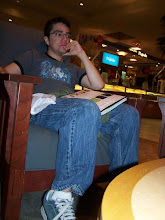 You can't judge a book by its cover, or by the first few hundred pages in the case of Jane Austen's Pride and Prejudice.
You can't judge a book by its cover, or by the first few hundred pages in the case of Jane Austen's Pride and Prejudice.I had this book sitting out at the studio I work for, and one of our actors stopped by, picked it up, and asked aloud, "All right, which one of you is being forced to read this for school?" I admitted that I was reading the book. Not only that, but I graduated two years ago and decided to read Pride and Prejudice for the fun of it.
Why? he asked. Because, I replied, I wanted to give Jane Austen a chance. I wanted to see what the big deal was, why women love her books so much. So here's the question, did I get lured into her romantic tales of middle class England?
Nope. Reading the first hundred or more pages of Pride and Prejudice left me wondering why women found this romantic? Mr. Darcy and Elizabeth barely play a role in the first two parts of the novel. Instead, we're subjected to a plot revolving around Elizabeth's older sister Jane and a failed marriage proposal. We get glimpses of Darcy and Elizabeth, and they are totally uninteresting as characters. Minor characters like Mr. and Mrs. Bennet, Mr. Collins, and Lady Catherine are funnier and more interesting. They stand out as characters with personalities, often comical in nature.
And man, I can't believe how boring most of Pride and Prejudice is. Oh, I know, I'm a guy, of course I think love stories are boring. But nothing happens for chapters at a time! I kid you not, I read a whole chapter that involved the characters taking a nap and reading. While I understand this is a representation of life back then, the story could use a little more trimming to get to the point.
Add to that the fact that Jane Austen doesn't write dialog. She'll write the first two lines of dialog exchanged between characters, and then follows it with a summary of what those characters talk about. I don't want to read a summary; I want to read the actual conversation. As Alice says in Alice's Adventures in Wonderland: "What is the use of a book without pictures or conversation?"
All this was true until I came to Part III of the book, and this is where it suddenly picks up with unbelievable speed. Elizabeth's little sister Lydia (another interesting, but minor character) runs off with a hooligan and the father trying to hunt her down and the family is on the brink of embarrassment. Mr. Darcy's feelings for Elizabeth come out, and both of them start having real emotions and turmoil and drama. Added to that, there is a real conversation between Elizabeth and Lady Catherine that is dramatic and well written. It's the only real conversation in the whole book.
In otherwords, Part III almost makes up for the slow and dry Parts I and II. Reading Pride and Prejudice is sort of like Elizabeth meeting Mr. Darcy. At first, you get one impression that isn't terribly flattering: it is uninteresting, incomplete, and more often than not, irritating. Then in the final third you get a revelation that makes you fall in love. Well, I'm exaggerating, but my point is that it took me weeks to read Parts I and II and a day or so to read Part III because I couldn't put it down.
If only Jane Austen had chopped down the first two thirds of the book, or at least given them the same flair as the final chapters.
Maybe the movie is better. I'll have to check it out.

Well, nice to know you liked my book! For us today, this book is a glimpse into the way relationships may have been during this time; this is something that we must remember while reading these books. And are you to tell me that all books must have a substantial amount of dialog to be interesting?
ReplyDelete